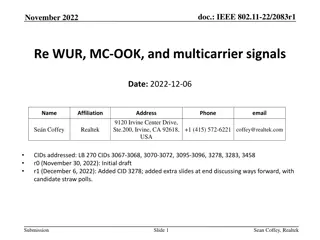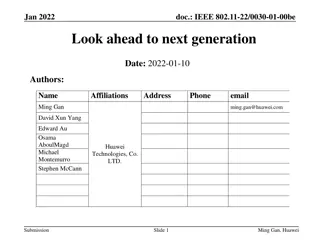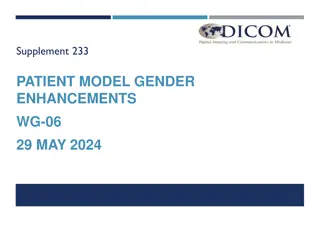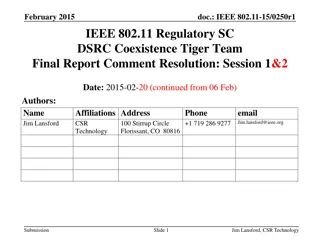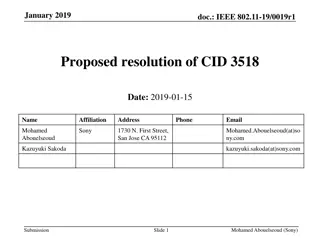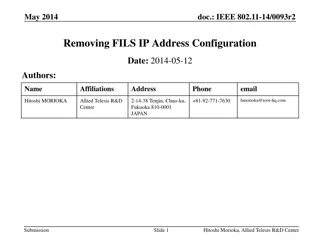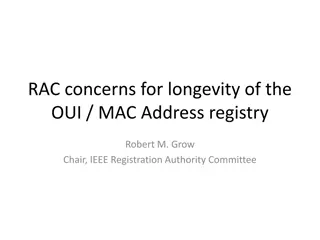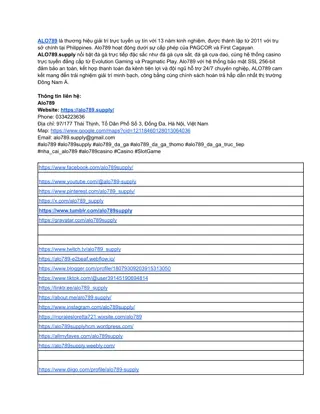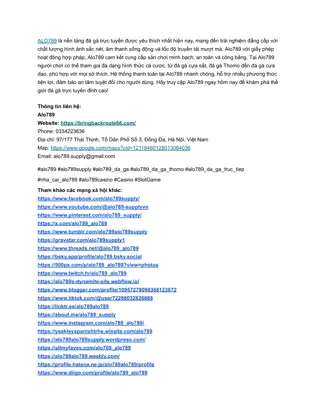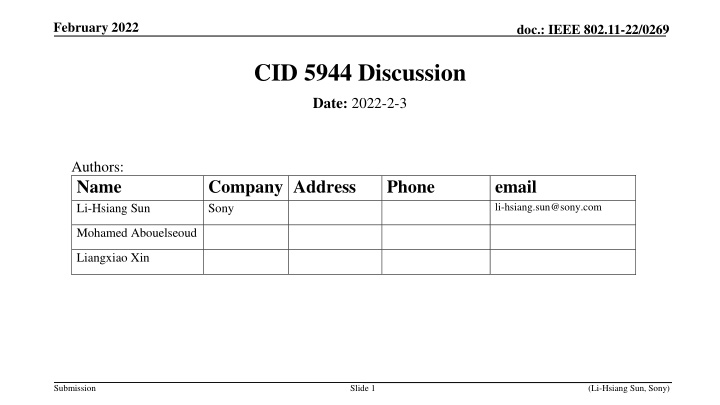
IEEE 802.11-22/0269 Discussion and Proposal Summary
Explore the detailed discussion on access restrictions for NSTR mobile APs and STAs associated with them. The proposal suggests allowing UL access from MLD on the secondary link with end of PPDU alignment, introducing exceptions to current procedures for enhanced efficiency and reduced contention. Discover the complexities faced by mobile APs in scheduling TB-PPDUs and the need for mechanisms to ensure efficient access in varying scenarios.
Download Presentation

Please find below an Image/Link to download the presentation.
The content on the website is provided AS IS for your information and personal use only. It may not be sold, licensed, or shared on other websites without obtaining consent from the author. If you encounter any issues during the download, it is possible that the publisher has removed the file from their server.
You are allowed to download the files provided on this website for personal or commercial use, subject to the condition that they are used lawfully. All files are the property of their respective owners.
The content on the website is provided AS IS for your information and personal use only. It may not be sold, licensed, or shared on other websites without obtaining consent from the author.
E N D
Presentation Transcript
February 2022 doc.: IEEE 802.11-22/0269 CID 5944 Discussion Date: 2022-2-3 Authors: Name Li-Hsiang Sun Company Address Sony Phone email li-hsiang.sun@sony.com Mohamed Abouelseoud Liangxiao Xin Submission Slide 1 (Li-Hsiang Sun, Sony)
February 2022 doc.: IEEE 802.11-22/0269 5944 Li-Hsiang Sun Yes 35.3.17.1 284 33 T 35.3.17.1 284.33 The spec should allow high priority non-AP to access on nonprimary link if it can align the end time of PPDU with the UL PPDU on the primary link as in comment MAC Volunteers: Rubayet Shafin, Gaurang Naik, Liuming Lu, Abhishek Patil, Alfred Asterjadhi, Tomo Adachi Assigned kaiying Lu Submission Slide 2 (Li-Hsiang Sun, Sony)
February 2022 doc.: IEEE 802.11-22/0269 Background The current procedure in D1.3 has following access restrictions defined for an NSTR mobile AP MLD and a STA associated with an NSTR mobile AP MLD A STA affiliated with the non-AP MLD may initiate a PPDU transmission to its associated AP affiliated with the NSTR mobile AP MLD in the nonprimary link only if the STA affiliated with the same MLD in the primary link is also initiating the PPDU as a TXOP holder with the same start time. An AP affiliated with the NSTR mobile AP MLD may initiate a PPDU transmission to its associated non-AP STA in the nonprimary link only if the AP affiliated with the same NSTR mobile AP MLD in the primary link is also initiating the PPDU as a TXOP holder with the same start time. Support of MU operation is optional for the APs affiliated with a mobile AP MLD More complexity for mobile AP to schedule TB-PPDUs (e.g. rate control for each non-AP on different links) Easier to implement SU scheduling or EDCA MLD/STA who transmits non-RTA traffic in a long TXOP on the primary link blocks the access of other MLDs who wishes to transmit RTA traffic because: RTA MLD loses contention on the primary link to a non-RTA STA, or RTA MLD has newly arrived RTA traffic in the middle of a TXOP of non-RTA STA It is desirable to have an access mechanism which allows RTA MLD to access 2ndary link while the primary link is occupied Submission Slide 3 (Li-Hsiang Sun, Sony)
February 2022 doc.: IEEE 802.11-22/0269 Proposed exception Allow UL access from an MLD on the secondary link with end of PPDU alignment with the intra BSS UL PPDU from another STA/MLD on the primary link TXOP limit=0 for such secondary link access The rate and the number of MPDUs (in a PPDU) for such secondary link access does not result in an immediate ack/BA on secondary link longer than a fixed duration (e.g. duration of an Ack frame in non-HT format on the primary link with the highest basic rate on the primary link) EDCA UL PPDU1 Mobile AP MLD primary link BA STAx (best effort) EDCA UL PPDU2 Mobile AP MLD secondary link BA Non-AP MLD (low latency) Low latency traffic arrival at non-AP MLD Submission Slide 4 (Li-Hsiang Sun, Sony)
February 2022 doc.: IEEE 802.11-22/0269 Implemented simulator functionalities NSTR Self-interference PPDU start time alignment with waited EDCA on secondary link for PPDUs from the same MLD on different links (no waited EDCA on primary link) PPDU end time alignment for PPDUs from the same MLD on different links Baseline mobile AP BSS rule, i.e. data transmission on secondary link occurs (subject to EDCA) only when primary link also transmits from the same MLD DL transmission to 2 different MLDs on primary and secondary link Allowing secondary link responder to send BA on secondary link only UL PPDU end time alignment for PPDUs from different MLDs (suggested enhancement) Observing primary link intra BSS UL PPDU from another MLD and performing EDCA access on secondary link using end- time alignment with primary link PPDU Submission Slide 5 (Li-Hsiang Sun, Sony)
February 2022 doc.: IEEE 802.11-22/0269 Topology A MLD2~4 are associated with Soft AP MLD1 2 links: Primary (link1/wifi1) and Secondary(link2/wifi2), each 80MHZ BW Fixed MCS QPSK for Data, QPSK1/2 for BA Tested traffic sources: UL FTP source with 50MB file (AC 0), MPDU size 618B UL CBR source with 1400B per ms (AC 3), MPDU size 1470B To which MLD a source is attached is described in the next slide FTP/AC 0 TXOP limit=5ms or 0 AC0: AIFSN=9, CW=15~1023 AC3: AIFSN=2, CW=3~7 NSTR MLD 3 NSTR MLD 4 10m 10m NSTR MLD 2 Soft AP-MLD 1 Submission Slide 6 (Li-Hsiang Sun, Sony)
February 2022 doc.: IEEE 802.11-22/0269 Scenarios and Cases 3 scenarios, each scenario has several cases Delivered FTP traffic volume per source and CDF of CBR e2e delay are measured for 5 seconds duration Scenarios: 1. MLD3 CBR, MLD2 FTP 2. MLD3 CBR, MLD2 FTP, MLD4 FTP 3. MLD3 CBR, MLD2 FTP, MLD4 CBR Cases: 12000 (baseline): for testing the baseline mobile AP access with a long PPDU and a long TXOP for non-RTA AC and default TID-link mapping baseline mobile AP(D1.3), secondary link can tx only when primary link tx, i.e. start and end align for NSTR non-AP MLD. Each AMPDU can fit at most 12KB (~19 FTP MPDUs). TXOP for AC0 is 5ms 4000: for testing the baseline mobile AP access with a short PPDU and a very short TXOP for non-RTA AC and default TID-link mapping Same as 12000 but max AMPDU length is 4KB, and TXOP limit is 0 tm12: for testing the baseline mobile AP access with a long PPDU and a long TXOP for non-RTA AC and non-default TID-link mapping Same as 12000 but with AC0 mapped to primary link only, AC3 mapped to both primary and secondary links al12: for testing the proposed access with a long PPDU and a long TXOP for non-RTA AC and non-default TID-link mapping Same as tm12 but allowing UL AC3 secondary link EDCA access when primary link has an intra BSS UL PPDU, i.e. UL end-alignment for different MLDs al6: for testing the proposed access with a medium size PPDU and a long TXOP for non-RTA AC and non-default TID-link mapping Same as al12 but each AMPDU fits at most 6KB (~9 FTP MPDUs) al4: for testing the proposed access with a small size PPDU and a long TXOP for non-RTA AC and non-default TID-link mapping Same as al12 but each AMPDU fits at most 4KB (~6 FTP MPDUs) Submission Slide 7 (Li-Hsiang Sun, Sony)
February 2022 doc.: IEEE 802.11-22/0269 Test results (Scenario 1) (per source node) Channel snapshot (each block is a PPDU) 12000 al6 al4 al12 tm12 secondary primary Submission Slide 8 (Li-Hsiang Sun, Sony)
February 2022 doc.: IEEE 802.11-22/0269 Test results (Scenario 2) (per source node) Channel snapshot 12000 al6 al4 al12 tm12 secondary primary Submission Slide 9 (Li-Hsiang Sun, Sony)
February 2022 doc.: IEEE 802.11-22/0269 Test results (Scenario 3) (per source node) Channel snapshot 4000 al6 al12 al4 12000 secondary primary Submission Slide 10 (Li-Hsiang Sun, Sony)
February 2022 doc.: IEEE 802.11-22/0269 Topology B (OBSS) MLD1 link 1 40MHz BW overlaps with APx half of 80MHz BW Scenario: MLD3 CBR, MLD2 UL FTP, OBSS APx DL FTP FTP/AC 0 TXOP limit=5ms for MLD2, FTP/AC 0 TXOP limit=3ms for legacy APx Cases: Baseline: same as 12000 (baseline) in p7 al12: same as al12 in p7 al4: same as al4 in p7 al4+: same as al4 but AC0 is mapped to both links for MLD2 but MLD2 link1 txop limit=5ms on link 1 and txop limit=3.5ms on link 2 APx primary ch is located in the 40MHz not occupied by MLD1's 40MHz 10m 15m 15m 35m Soft AP-MLD 1 Link 1,2, 40MHz each MLD2 MLD3 OBSS APx link 1, 80MHz EDCA UL PPDU1 EDCA UL PPDU3 Mobile AP MLD1 primary link BA BA MLD2 (best effort) EDCA UL PPDU2 BA Mobile AP MLD1 secondary link MLD2 (best effort) EDCA UL PPDU4 BA Mobile AP MLD1 secondary link MLD3 (delay sensitive) Submission Slide 11 (Li-Hsiang Sun, Sony)
February 2022 doc.: IEEE 802.11-22/0269 Topology B (OBSS) The reason the baseline delay is bad because APx can start 80MHz TXOP when MLD2 has ongoing 40MHz TXOP, blocking MLD3 on link1 Allowing UL end-aligned transmission from MLD3 on link2 alleviates the issue Allowing MLD2 to be mapped to link2 but with a shorter TXOP limit (al4+) reduces penalty to MLD2 while MLD1 still get acceptable delay Submission Slide 12 (Li-Hsiang Sun, Sony)
February 2022 doc.: IEEE 802.11-22/0269 Observations TID to link mapping does not work by itself when applied to a mobile AP BSS for improving latency tm case in previous results All traffic must be mapped to primary link, which is the bottleneck Bad performance for both CBR and FTP TID to link mapping can improve latency (at the expense of FTP volume) if allowing latency sensitive traffic to be end-aligned on secondary link with an intra BSS UL PPDU sent by another MLD on primary link, i.e. UL end alignment from different MLDs al_12/6/4 cases in previous results By enforcing a small PPDU size and TXOP limit=0 for low priority traffic mapped on both links (4000 case in scenario 3), the latency for high priority traffic can be satisfied but low priority throughput suffers even more when compared with mapping only 1 link to the low priority traffic With end alignment from different MLDs, the max PPDU length on the primary link affects latency With shorter UL PPDU length on the primary link, more access opportunities for higher priority traffic UL access on secondary link with UL end alignment, at the expense of a higher overhead on the primary link With longer UL PPDU length on primary link, the overhead on the primary link is smaller but access opportunities for higher priority on secondary link reduces, causing more high priority MLD to access primary link. The resulting FTP throughput on primary link does not change significantly compared to shorter UL AMPDU length on the primary link Submission Slide 13 (Li-Hsiang Sun, Sony)
February 2022 doc.: IEEE 802.11-22/0269 Straw Polls 1. Do you agree to allow UL PPDU end time alignment for PPDUs from a STR MLDs on the primary and secondary link in a mobile AP BSS? i.e. star time is allowed not to be aligned 2. Do you agree to allow UL PPDU end time alignment for PPDUs from different MLDs on the primary and secondary link in a mobile AP BSS? Submission Slide 14 (Li-Hsiang Sun, Sony)
February 2022 doc.: IEEE 802.11-22/0269 Proposed resolution: revised Modify the last paragraph of 35.3.19.1 STAs affiliated with a non-AP MLD that is associated with an NSTR mobile AP MLD and APs affiliated with an NSTR mobile AP MLD shall follow the procedure defined in 35.3.16.6 (Start time sync PPDUs medium access) when intending to transmit in the nonprimary link with the following additional constraints and with the exceptions of (a) and (b) below. A STA affiliated with the non-AP MLD may initiate a PPDU transmission to its associated AP affiliated with the NSTR mobile AP MLD in the nonprimary link only if the STA affiliated with the same MLD in the primary link is also initiating the PPDU as a TXOP holder with the same start time. An AP affiliated with the NSTR mobile AP MLD may initiate a PPDU transmission to its associated non-AP STA in the nonprimary link only if the AP affiliated with the same NSTR mobile AP MLD in the primary link is also initiating the PPDU as a TXOP holder with the same start time. (a) A STA operating on the nonprimary link and affiliated with a non-AP MLD which has a pair of setup links that is a STR link pair, may perform the same channel access procedure as described in 35.3.16.5 (PPDU end time alignment) for the AP MLD, or (b) A STA operating on the nonprimary link and affiliated with a non-AP MLD may perform channel access assuming a TXOP limit equal to 0 when a backoff counter of the STA reaches zero, if the non-AP MLD has detected an ongoing UL intra-BSS PPDU transmission on the primary link. The PPDU in the channel access shall be end-aligned with the ongoing primary link PPDU and the PDDU shall not solicit an immediate response with a TXTIME that is longer than an Ack frame transmitted in non-HT format using the highest basic rate on the primary link. The STA operating on the nonprimary link and affiliated with the non-AP MLD, upon the non-AP MLD detecting an ongoing UL intra-BSS PPDU on the primary link, and the STA having a backoff counter already reached zero, may perform a new backoff procedure following deferral procedures as described in 10.23.2.4 (Obtaining an EDCA TXOP) and 10.3.4.3 (Backoff procedure for DCF). CW[AC] and QSRC[AC] are left unchanged. Submission Slide 15 (Li-Hsiang Sun, Sony)
February 2022 doc.: IEEE 802.11-22/0269 BACKUP Submission Slide 16 (Li-Hsiang Sun, Sony)
February 2022 doc.: IEEE 802.11-22/0269 Scenarios with DL traffic AP MLD MLD2 MLD3 MLD4 Scenario4 DL FTP UL FTP UL cbr UL cbr Scenario5 DL cbr UL FTP UL cbr UL cbr Scenario6 DL cbr UL FTP UL cbr UL cbr (UL MCS 16QAM ) Unless otherwise specified: cbr: AC_VO, AIFSN=2, CW=3~7, mapped to both links, interval/size described in previous slides FTP: AC_BE, AIFSN=9, CW=15~1023, mapped to both links, for 5 sec MCS corresponding to QPSK for data, MCS corresponding to QPSK for BA UL/DL AC_BE TXOP=1ms (addressing the case long DL/UL AC_BE TXOP blocking DL RTA traffic ) Perform TX on both links if both links EDCA BO counter=0 and has at least 2 MPDUs buffered Max AMPDU 4000B Submission Slide 17 (Li-Hsiang Sun, Sony)
February 2022 doc.: IEEE 802.11-22/0269 Access parameters/methods Case1 Case2 Use end-alignment on link2 UL FTP mapped to primary link only Scenario4 D1.31 access rule Use end-alignment on secondary link UL AC_BE AIFSN=4 UL AC_BE CW=7~15 UL FTP mapped to primary link only Use end-alignment on secondary link UL FTP mapped to primary link only Scenario5 D1.31 access rule Scenario6 D1.31 access rule Submission Slide 18 (Li-Hsiang Sun, Sony)
February 2022 doc.: IEEE 802.11-22/0269 Scenario 4 Submission Slide 19 (Li-Hsiang Sun, Sony)
February 2022 doc.: IEEE 802.11-22/0269 Scenario 5 DL UL Submission Slide 20 (Li-Hsiang Sun, Sony)
February 2022 doc.: IEEE 802.11-22/0269 Scenario 6 DL UL Submission Slide 21 (Li-Hsiang Sun, Sony)



